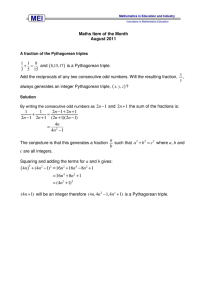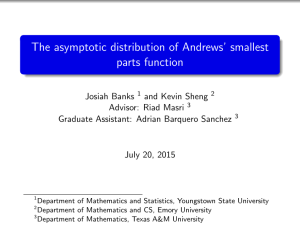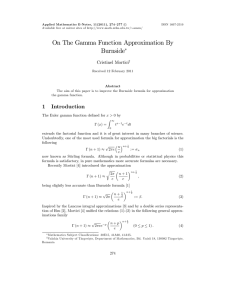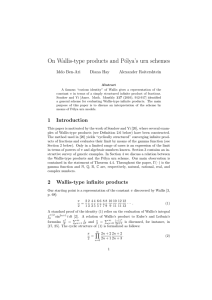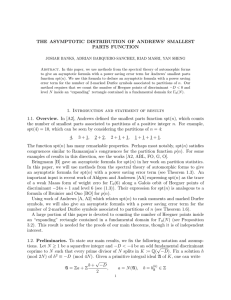INTEGERS 12 (2012) #A54 THE NUMBER OF REPRESENTATIONS OF A NUMBER AS
advertisement
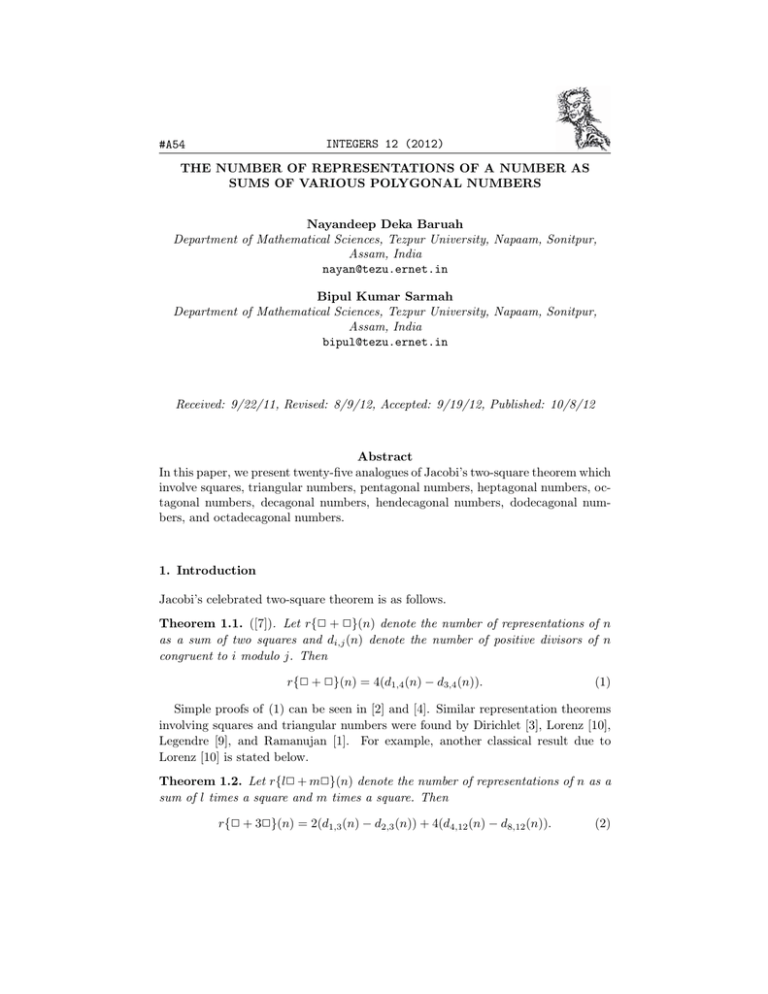
INTEGERS 12 (2012)
#A54
THE NUMBER OF REPRESENTATIONS OF A NUMBER AS
SUMS OF VARIOUS POLYGONAL NUMBERS
Nayandeep Deka Baruah
Department of Mathematical Sciences, Tezpur University, Napaam, Sonitpur,
Assam, India
nayan@tezu.ernet.in
Bipul Kumar Sarmah
Department of Mathematical Sciences, Tezpur University, Napaam, Sonitpur,
Assam, India
bipul@tezu.ernet.in
Received: 9/22/11, Revised: 8/9/12, Accepted: 9/19/12, Published: 10/8/12
Abstract
In this paper, we present twenty-five analogues of Jacobi’s two-square theorem which
involve squares, triangular numbers, pentagonal numbers, heptagonal numbers, octagonal numbers, decagonal numbers, hendecagonal numbers, dodecagonal numbers, and octadecagonal numbers.
1. Introduction
Jacobi’s celebrated two-square theorem is as follows.
Theorem 1.1. ([7]). Let r{✷ + ✷}(n) denote the number of representations of n
as a sum of two squares and di,j (n) denote the number of positive divisors of n
congruent to i modulo j. Then
r{✷ + ✷}(n) = 4(d1,4 (n) − d3,4 (n)).
(1)
Simple proofs of (1) can be seen in [2] and [4]. Similar representation theorems
involving squares and triangular numbers were found by Dirichlet [3], Lorenz [10],
Legendre [9], and Ramanujan [1]. For example, another classical result due to
Lorenz [10] is stated below.
Theorem 1.2. Let r{l✷ + m✷}(n) denote the number of representations of n as a
sum of l times a square and m times a square. Then
r{✷ + 3✷}(n) = 2(d1,3 (n) − d2,3 (n)) + 4(d4,12 (n) − d8,12 (n)).
(2)
2
INTEGERS: 12 (2012)
In [5], M.D. Hirschhorn obtained sixteen identities (including those obtained
by Legendre and Ramanujan) simply by dissecting the q-series representations of
the identities obtained by Jacobi, Dirichlet and Lorenz. Hirschhorn [6] further
extended his work and obtained twenty-nine more identities involving squares, triangular numbers, pentagonal numbers and octagonal numbers. For more work on
this topic one can see [8], [11] and [12]. In [12], R. S. Melham presented an informal account of analogues of Jacobi’s two-square theorem which are verified using
computer algorithms.
In this paper, we find twenty-five more such identities involving squares, triangular numbers, pentagonal numbers, heptagonal numbers, octagonal numbers,
decagonal numbers, hendecagonal numbers, dodecagonal numbers, and octadecagonal numbers, by employing Ramanujan’s theta function identities.
For k ≥ 3, the nth k-gonal number Fk (n) is given by
Fk := Fk (n) =
(k − 2)n2 − (k − 4)n
.
2
By allowing the domain for Fk (n) to be the set of all integers, we see that the
generating function Gk (q) of Fk (n) is given by
Gk (q) =
∞
�
q Fk =
n=−∞
∞
�
(k − 2)n2 − (k − 4)n
2
q
.
n=−∞
We note an exception for the case k = 3. We observe that G3 (q) generates each
triangular number twice while G6 (q) generates each only once. As such, we take
G6 (q) as the generating function for triangular numbers instead of G3 (q). We
further observe that
Gk (q) = f (q, q k−3 ),
(3)
where f (a, b) is Ramanujan’s general theta function defined by [1, p. 34, Eq. (18.1)]:
f (a, b) :=
∞
�
an(n+1)/2 bn(n−1)/2 ,
n=−∞
|ab| < 1.
Two important special cases of f (a, b) are
ϕ(q) := f (q, q),
ψ(q) := f (q, q 3 ).
In view of (3), the respective generating functions of squares, triangular numbers,
pentagonal numbers, heptagonal numbers, octagonal numbers, decagonal numbers,
3
INTEGERS: 12 (2012)
hendecagonal numbers, dodecagonal numbers, and octadecagonal numbers are
G4 (q) = f (q, q) = ϕ(q),
G6 (q) = f (q, q 3 ) = ψ(q),
G5 (q) = f (q, q 2 ),
G7 (q) = f (q, q 4 ),
G8 (q) = f (q, q 5 ),
G10 (q) = f (q, q 7 ),
G11 (q) = f (q, q 8 ),
G12 (q) = f (q, q 9 ),
and
G18 (q) = f (q, q 15 ).
In Section 2, we give dissections of ϕ(q), ψ(q), G5 (q), and G12 (q) and recall some
identities established in [5] and [6]. In the remaining five sections, we successively
present sets of identities involving decagonal numbers, hendecagonal numbers, dodecagonal numbers, heptagonal numbers, and octadecagonal numbers.
2. Preliminary Results
Let Un = an(n+1)/2 bn(n−1)/2 and Vn = an(n−1)/2 bn(n+1)/2 for each integer n. Then
we have [1, p. 48, Entry 31]
�
�
n−1
�
Un+r Vn−r
f (a, b) = f (U1 , V1 ) =
Ur f
,
.
Ur
Ur
r=0
Replacing a by q a and b by q b , we find that
a+b 2 a−b
n−1
� 2 r + 2 r
f (q a , q b ) =
q
r=0
×f
q
a+b 2
a−b
n +(a+b)nr+
n
2
2
a+b 2
a−b
n −(a+b)nr−
n
2
2
.
,q
(4)
Setting a = b = 1 and then letting n = 3, 5 and 8 in (4), we obtain
ϕ(q) = ϕ(q 9 ) + 2qG8 (q 3 ),
(5)
ϕ(q) = ϕ(q 25 ) + 2qA(q 5 ) + 2q 4 G12 (q 5 ),
(6)
4
INTEGERS: 12 (2012)
and
ϕ(q) = ϕ(q 64 ) + 2qB(q 16 ) + 2q 4 ψ(q 32 ) + 2q 9 G10 (q 16 ) + 2q 16 ψ(q 128 ),
(7)
respectively, where A(q) = f (q 3 , q 7 ) and B(q) = f (q 3 , q 5 ).
Setting a = 1, b = 3 and then putting n = 2, 4 and 6 in (4), we deduce that
ψ(q) = B(q 2 ) + qG10 (q 2 ),
(8)
ψ(q) = f (q , q ) + qf (q , q ) + q f (q , q ) + q G18 (q ),
28
36
20
44
3
12
52
6
4
(9)
and
ψ(q) = f (q 66 , q 78 ) + qB(q 18 ) + q 3 f (q 42 , q 102 ) + q 6 f (q 30 , q 114 )
+ q 10 G10 (q 18 ) + q 15 G26 (q 6 ),
(10)
respectively.
Setting a = 1, b = 0 and then choosing n = 3 and 5 in (4) and noting that
1
ψ(q) = f (1, q), we obtain
2
ψ(q) = G5 (q 3 ) + qψ(q 9 )
(11)
ψ(q) = C(q 5 ) + qG7 (q 5 ) + q 3 ψ(q 25 ),
(12)
and
respectively, where C(q) = f (q 2 , q 3 ).
Next, setting a = 1, b = 2 and n = 3 in (4), we find that
G5 (q) = f (q 12 , q 15 ) + qf (q 6 , q 21 ) + q 2 G11 (q 3 ).
(13)
Again, setting a = 1, b = 9 and n = 2 in (4), we obtain
G12 (q) = A(q 4 ) + qG7 (q 8 ).
(14)
We also require a few identities deduced in [5] and [6]. Throughout the sequel,
r{lFi + mFj }(n) denotes the number of representations of n as a sum of l times a
polygonal number Fi and m times a polygonal number Fj . Note that r{2✷ + �}(n)
that appears in (16) is r{2F4 + F6 }(n). However, we have kept the former notation
in those cases which involve squares and/or triangular numbers. The first seven
of the following identities appeared in [5] as equations (1.1), (1.3), (1.4), (1.5),
(1.11), (1.12), and (1.14), respectively, while the last six identities appeared in [6]
as equations (1.2), (1.3), (1.4), (1.6), (1.13), and (1.14), respectively.
INTEGERS: 12 (2012)
r{� + �}(n) = d1,4 (4n + 1) − d3,4 (4n + 1),
5
(15)
r{2✷ + �}(n) = d1,4 (8n + 1) − d3,4 (8n + 1),
(16)
1
r{� + 4�}(n) = (d1,4 (8n + 5) − d3,4 (8n + 5)),
(17)
2
1
r{� + 2�}(n) = (d1,8 (8n + 3) + d3,8 (8n + 3) − d5,8 (8n + 3) − d7,8 (8n + 3)),
2
(18)
r{6✷ + �}(n) = d1,3 (8n + 1) − d2,3 (8n + 1),
1
r{� + 12�}(n) = (d1,3 (8n + 13) − d2,3 (8n + 13)),
2
1
r{3� + 4�}(n) = (d1,3 (8n + 7) − d2,3 (8n + 7)),
2
r{� + 4F5 }(n) = d1,24 (24n + 7) + d19,24 (24n + 7) − d5,24 (24n + 7)
(19)
r{3� + F5 }(n) = d1,12 (12n + 5) − d11,12 (12n + 5),
(23)
r{6� + F5 }(n) = d1,8 (24n + 19) − d7,8 (24n + 19),
(25)
− d23,24 (24n + 7),
r{3� + 2F5 }(n) = d1,8 (24n + 11) − d7,8 (24n + 11),
r{3✷ + F5 }(n) = d1,8 (24n + 1) + d3,8 (24n + 1) − d5,8 (24n + 1)
− d7,8 (24n + 1),
(20)
(21)
(22)
(24)
(26)
r{3✷ + 4F5 }(n) = d1,8 (6n + 1) + d3,8 (6n + 1) − d5,8 (6n + 1) − d7,8 (6n + 1). (27)
3. Identities Involving Decagonal Numbers
Theorem 3.1. We have
r{✷ + 3F10 }(n) = d1,3 (16n + 27) − d2,3 (16n + 27),
1
r{2� + 3F10 }(n) = (d1,3 (16n + 31) − d2,3 (16n + 31)),
2
1
r{2� + F10 }(n) = (d1,4 (16n + 13) − d3,4 (16n + 13)),
2
r{✷ + F10 }(n) = d1,4 (16n + 9) − d3,4 (16n + 9),
1
r{6� + F10 }(n) = (d1,3 (16n + 21) − d2,3 (16n + 21)),
2
(28)
(29)
(30)
(31)
(32)
6
INTEGERS: 12 (2012)
r{3✷ + F10 }(n) = d1,3 (16n + 9) − d2,3 (16n + 9),
1
r{F8 + F10 }(n) = (d1,3 (48n + 43) − d2,3 (48n + 43)),
2
r{F5 + 3F10 }(n) = d1,8 (48n + 83) − d7,8 (48n + 83),
r{2F5 + F10 }(n) = d1,24 (48n + 31) + d19,24 (48n + 31)
− d5,24 (48n + 31) − d23,24 (48n + 31),
1
r{� + F10 }(n) = (d1,8 (16n + 11) + d3,8 (16n + 11)
2
− d5,8 (16n + 11) − d7,8 (16n + 11)).
Proof. Identity (19) is equivalent to
�
ϕ(q 6 )ψ(q) =
(d1,3 (8n + 1) − d2,3 (8n + 1))q n .
(33)
(34)
(35)
(36)
(37)
(38)
n≥0
Employing (10) in (38), we have
ϕ(q 6 )(f (q 66 , q 78 ) + qB(q 18 ) + q 3 f (q 42 , q 102 ) + q 6 f (q 30 , q 114 )
�
+ q 10 G10 (q 18 ) + q 15 G26 (q 6 )) =
(d1,3 (8n + 1) − d2,3 (8n + 1))q n .
(39)
n≥0
Extracting the terms involving q 6n+4 in (39) and then dividing the resulting identity
by q 4 and replacing q 6 by q, we find that
�
qϕ(q)G10 (q 3 ) =
(d1,3 (48n + 33) − d2,3 (48n + 33))q n .
(40)
n≥0
Equating the coefficients of q
on both sides of (40) and noting that d1,3 (48n +
33) = d1,3 (16n + 11) and d2,3 (48n + 33) = d2,3 (16n + 11), we arrive at (28).
Next, (20) is equivalent to
1�
ψ(q)ψ(q 12 ) =
(d1,3 (8n + 13) − d2,3 (8n + 13))q n ,
2
n+1
n≥0
which, with the aid of (10), can be rewritten as
�
ψ(q 12 ) f (q 66 , q 78 ) + qB(q 18 ) + q 3 f (q 42 , q 102 ) + q 6 f (q 30 , q 114 )
�
+ q 10 G10 (q 18 ) + q 15 G26 (q 6 )
=
1�
(d1,3 (8n + 13) − d2,3 (8n + 13))q n .
2
(41)
n≥0
Collecting the terms in (41) in which the power of q is congruent to 4 modulo 6, we
find that
1�
qψ(q 2 )G10 (q 3 ) =
(d1,3 (48n + 45) − d2,3 (48n + 45))q n .
(42)
2
n≥0
7
INTEGERS: 12 (2012)
Equating the coefficients of q n+1 on both sides of (42) and noting that d1,3 (48n +
45) = d1,3 (16n + 15) and d2,3 (48n + 45) = d2,3 (16n + 15), we arrive at (29).
Identity (1) is equivalent to
�
ϕ2 (q) = 1 + 4
(d1,4 (n) − d3,4 (n))q n ,
(43)
n≥1
which can be rewritten, with the aid of (7), as
(ϕ(q 64 ) + 2qB(q 16 ) + 2q 4 ψ(q 32 ) + 2q 9 G10 (q 16 ) + 2q 16 ψ(q 128 ))2
�
=1+4
(d1,4 (n) − d3,4 (n))q n .
(44)
n≥1
Now, we extract those terms in (44) where the power of q is congruent to 13 modulo
16, divide the resulting identity by q 13 and replace q 16 by q, to obtain
ψ(q 2 )G10 (q) =
1�
(d1,4 (16n + 13) − d3,4 (16n + 13))q n ,
2
n≥0
which readily yields (30).
Next, extracting those terms in (44) where the power of q is congruent to 9
modulo 16, then dividing the resulting identity by q 9 and replacing q 16 by q, we
have
�
G10 (q)(ϕ(q 4 ) + 2qψ(q 8 )) =
(d1,4 (16n + 9) − d3,4 (16n + 9))q n .
(45)
n≥0
But, setting a = b = 1 and n = 2 in (4), or from [1, p. 40, Entries 25(i) and
25(ii)], we have
ϕ(q) = ϕ(q 4 ) + 2qψ(q 8 ).
(46)
Employing (46) in (45), we find that
�
ϕ(q)G10 (q) =
(d1,4 (16n + 9) − d3,4 (16n + 9))q n ,
n≥0
which implies (31).
Now, (2) is equivalent to
�
�
ϕ(q)ϕ(q 3 ) = 1 + 2
(d1,3 (n) − d2,3 (n))q n + 4
(d4,12 (n) − d8,12 (n))q n
n≥1
=1+2
�
(d1,3 (n) − d2,3 (n))q n + 4
n≥1
n≥1
�
(d1,3 (n) − d2,3 (n))q 4n .
n≥1
(47)
8
INTEGERS: 12 (2012)
Employing (7) in (47), we have
(ϕ(q 64 ) + 2qB(q 16 ) + 2q 4 ψ(q 32 ) + 2q 9 G10 (q 16 ) + 2q 16 ψ(q 128 ))
× (ϕ(q 192 ) + 2q 3 B(q 48 ) + 2q 12 ψ(q 96 ) + 2q 27 G10 (q 48 ) + 2q 48 ψ(q 384 ))
�
�
=1+2
(d1,3 (n) − d2,3 (n))q n + 4
(d1,3 (n) − d2,3 (n))q 4n .
n≥1
(48)
n≥1
Extracting the terms in (48) involving q 16n+5 , then dividing the resulting identity
by q 5 and replacing q 16 by q, we find that
qψ(q 6 )G10 (q) =
1�
(d1,3 (16n + 5) − d2,3 (16n + 5))q n ,
2
n≥0
from which (32) can be easily deduced.
Again, using (5) in (40), we have
�
q(ϕ(q 9 ) + 2qG8 (q 3 ))G10 (q 3 ) =
(d1,3 (16n + 11) − d2,3 (16n + 11))q n .
(49)
n≥0
Separating the terms involving q 3n+1 and q 3n+2 in (49), we obtain
�
ϕ(q 3 )G10 (q) =
(d1,3 (48n + 27) − d2,3 (48n + 27))q n
(50)
n≥0
and
2G8 (q)G10 (q) =
�
(d1,3 (48n + 43) − d2,3 (48n + 43))q n ,
(51)
n≥0
respectively. Now the identities (33) and (34) follow easily from (50) and (51),
respectively.
Next, (24) is equivalent to
�
ψ(q 3 )G5 (q 2 ) =
(d1,8 (24n + 11) − d7,8 (24n + 11))q n .
(52)
n≥0
Invoking (8) in (52), we have
(B(q 6 ) + q 3 G10 (q 6 ))G5 (q 2 ) =
�
(d1,8 (24n + 11) − d7,8 (24n + 11))q n .
(53)
n≥0
Extracting the terms involving q 2n+1 in (53), we obtain
�
qG10 (q 3 )G5 (q) =
(d1,8 (48n + 35) − d7,8 (48n + 35))q n .
n≥0
(54)
9
INTEGERS: 12 (2012)
Comparing the coefficients of q n+1 on both sides of (54), we arrive at (35).
Identity (22) is equivalent to
ψ(q)G5 (q 4 )
=
�
(d1,24 (24n + 7) + d19,24 (24n + 7) − d5,24 (24n + 7) − d23,24 (24n + 7))q n .
n≥0
(55)
Using (8) in (55), we have
(B(q 2 ) + qG10 (q 2 ))G5 (q 4 ) =
�
(d1,24 (24n + 7) + d19,24 (24n + 7)
n≥0
− d5,24 (24n + 7) − d23,24 (24n + 7))q n .
(56)
Extracting the terms involving odd powers of q in (56), we obtain
G10 (q)G5 (q 2 )
�
=
(d1,24 (48n + 31) + d19,24 (48n + 31) − d5,24 (48n + 31) − d23,24 (48n + 31))q n ,
n≥0
which readily yields (36).
Identity (18) is equivalent to
ψ(q)ψ(q 2 ) =
1�
(d1,8 (8n + 3) + d3,8 (8n + 3) − d5,8 (8n + 3) − d7,8 (8n + 3))q n ,
2
n≥0
which, with the aid of (8), can be written as
(B(q 2 ) + qG10 (q 2 ))ψ(q 2 )
=
1�
(d1,8 (8n + 3) + d3,8 (8n + 3) − d5,8 (8n + 3) − d7,8 (8n + 3))q n .
2
(57)
n≥0
Extracting the terms involving q 2n+1 in (57), we obtain
G10 (q)ψ(q)
=
1�
(d1,8 (16n + 11) + d3,8 (16n + 11) − d5,8 (16n + 11) − d7,8 (16n + 11))q n .
2
n≥0
(58)
Equating the coefficients of q n on both sides of (58), we arrive at (37).
10
INTEGERS: 12 (2012)
4. Identities Involving Hendecagonal Numbers
Theorem 4.1. We have
r{� + F11 }(n) = d1,12 (36n + 29) − d11,12 (36n + 29),
r{� + 2F11 }(n) = d1,8 (72n + 107) − d7,8 (72n + 107),
r{2� + F11 }(n) = d1,8 (72n + 67) − d7,8 (72n + 67),
r{✷ + F11 }(n) = d1,8 (72n + 49) + d3,8 (72n + 49)
− d5,8 (72n + 49) − d7,8 (72n + 49),
r{✷ + 4F11 }(n) = d1,8 (18n + 49) + d3,8 (18n + 49)
− d5,8 (18n + 49) − d7,8 (18n + 49),
r{F10 + F11 }(n) = d1,8 (144n + 179) − d7,8 (144n + 179).
(59)
(60)
(61)
(62)
(63)
(64)
Proof. Identity (23) is equivalent to
�
ψ(q 3 )G5 (q) =
(d1,12 (12n + 5) − d11,12 (12n + 5))q n ,
n≥0
which we rewrite, by (13), as
ψ(q 3 )(f (q 12 , q 15 ) + qf (q 6 , q 21 ) + q 2 G11 (q 3 ))
�
=
(d1,12 (12n + 5) − d11,12 (12n + 5))q n .
(65)
n≥0
Extracting the terms involving q 3n+2 in (65), we obtain
�
ψ(q)G11 (q) =
(d1,12 (36n + 29) − d11,12 (36n + 29))q n ,
n≥0
which readily yields (59).
Next, (24) is equivalent to
ψ(q 3 )G5 (q 2 ) =
�
(d1,8 (24n + 11) − d7,8 (24n + 11))q n .
(66)
n≥0
Invoking (13) in (66), we find that
ψ(q 3 )(f (q 24 , q 30 ) + q 2 f (q 12 , q 42 ) + q 4 G11 (q 6 ))
=
�
(d1,8 (24n + 11) − d7,8 (24n + 11))q n .
n≥0
(67)
11
INTEGERS: 12 (2012)
Extracting the terms involving q 3n+1 in (67), we obtain
�
qψ(q)G11 (q 2 ) =
(d1,8 (72n + 35) − d7,8 (72n + 35))q n ,
(68)
n≥0
from which (60) follows.
Again, (25) is equivalent to
�
ψ(q 6 )G5 (q) =
(d1,8 (24n + 19) − d7,8 (24n + 19))q n .
(69)
n≥0
Using (13) in (69), we have
ψ(q 6 )(f (q 12 , q 15 ) + qf (q 6 , q 21 ) + q 2 G11 (q 3 ))
=
�
(d1,8 (24n + 19) − d7,8 (24n + 19))q n .
(70)
n≥0
Extracting the terms involving q 3n+2 in (70), we obtain
�
ψ(q 2 )G11 (q) =
(d1,8 (72n + 67) − d7,8 (72n + 67))q n ,
n≥0
which gives (61).
Identity (26) is equivalent to
�
ϕ(q 3 )G5 (q) =
(d1,8 (24n + 1) + d3,8 (24n + 1) − d5,8 (24n + 1) − d7,8 (24n + 1))q n ,
n≥0
and by (13), we have
ϕ(q 3 )(f (q 12 , q 15 ) + qf (q 6 , q 21 ) + q 2 G11 (q 3 ))
�
=
(d1,8 (24n + 1) + d3,8 (24n + 1) − d5,8 (24n + 1) − d7,8 (24n + 1))q n .
(71)
n≥0
Extracting the terms involving q 3n+2 in (71), we obtain
ϕ(q)G11 (q)
=
�
(d1,8 (72n + 49) + d3,8 (72n + 49) − d5,8 (72n + 49) − d7,8 (72n + 49))q n ,
n≥0
which readily yields (62).
Identity (27) is equivalent to
�
ϕ(q 3 )G5 (q 4 ) =
(d1,8 (6n + 1) + d3,8 (6n + 1) − d5,8 (6n + 1) − d7,8 (6n + 1))q n .
n≥0
(72)
12
INTEGERS: 12 (2012)
Using (13) in (72), we have
ϕ(q 3 )(f (q 48 , q 60 ) + q 4 f (q 24 , q 84 ) + q 8 G11 (q 12 ))
�
=
(d1,8 (6n + 1) + d3,8 (6n + 1) − d5,8 (6n + 1) − d7,8 (6n + 1))q n .
(73)
n≥0
Extracting the terms involving q 3n+2 in (73), we find that
�
q 2 ϕ(q)G11 (q 4 ) =
(d1,8 (18n + 13) + d3,8 (18n + 13)
n≥0
− d5,8 (18n + 13) − d7,8 (18n + 13))q n ,
which readily yields (63).
Again, employing (8) in (68), we obtain
�
q(B(q 2 ) + qG10 (q 2 ))G11 (q 2 ) =
(d1,8 (72n + 35) − d7,8 (72n + 35))q n .
(74)
n≥0
Comparing the terms in (74) where the powers of q are even, we find that
�
qG10 (q)G11 (q) =
(d1,8 (144n + 35) − d7,8 (144n + 35))q n .
(75)
n≥0
Equating the coefficients of q n+1 in (75), we arrive at (64).
5. Identities Involving Dodecagonal Numbers
Theorem 5.1. We have
r{5✷ + F12 }(n) = d1,4 (5n + 4) − d3,4 (5n + 4),
r{F12 + F12 }(n) = d1,4 (5n + 8) − d3,4 (5n + 8),
1
r{5� + F12 }(n) = (d1,4 (20n + 17) − d3,4 (20n + 17)).
2
(76)
(77)
(78)
Proof. Employing (6) in (43), we find that
(ϕ(q 25 ) + 2qA(q 5 ) + 2q 4 G12 (q 5 ))2 = 1 + 4
�
(d1,4 (n) − d3,4 (n))q n .
(79)
n≥1
Extracting those terms in (79) in which the power of q is congruent to 4 modulo 5,
we obtain
�
ϕ(q 5 )G12 (q) =
(d1,4 (5n + 4) − d3,4 (5n + 4))q n ,
n≥0
13
INTEGERS: 12 (2012)
from which (76) follows.
Again, extracting the terms involving q 5n+3 in (79), we have
�
qG212 (q) =
(d1,4 (5n + 3) − d3,4 (5n + 3))q n ,
(80)
n≥0
which immediately gives (77).
Furthermore, extracting the terms involving q 5n+2 in (79), we find that
�
A2 (q) =
(d1,4 (5n + 2) − d3,4 (5n + 2))q n .
(81)
n≥0
But, from [1, p. 46, Entries 30(v) and 30(vi)], we have
A2 (q) = f 2 (q 3 , q 7 ) = A(q 2 )ϕ(q 10 ) + 2q 3 G12 (q 4 )ψ(q 20 ).
(82)
From (81) and (82), we obtain
A(q 2 )ϕ(q 10 ) + 2q 3 G12 (q 4 )ψ(q 20 ) =
�
(d1,4 (5n + 2) − d3,4 (5n + 2))q n .
(83)
n≥0
Collecting the terms involving q 4n+3 in (83), we find that
�
2G12 (q)ψ(q 5 ) =
(d1,4 (20n + 17) − d3,4 (20n + 17))q n ,
n≥0
which readily yields (78).
6. Identities Involving Heptagonal Numbers
Theorem 6.1. We have
r{F7 + F7 }(n) = d1,4 (20n + 9) − d3,4 (20n + 9),
1
r{5� + F7 }(n) = (d1,4 (20n + 17) − d3,4 (20n + 17)),
2
1
r{2F12 + F7 }(n) = (d1,4 (40n + 73) − d3,4 (40n + 73)).
2
(84)
(85)
(86)
Proof. With the aid of (14), we rewrite (80) as
�
q(A(q 4 ) + qG7 (q 8 ))2 =
(d1,4 (5n + 3) − d3,4 (5n + 3))q n .
(87)
Extracting the terms involving q 8n+3 in (87), we find that
�
G27 (q) =
(d1,4 (40n + 18) − d3,4 (40n + 18))q n .
(88)
n≥0
n≥0
14
INTEGERS: 12 (2012)
Equating the coefficients of q n in (88) and noting the fact that d1,4 (40n + 18) =
d1,4 (20n + 9) and d3,4 (40n + 18) = d3,4 (20n + 9), we arrive at (84).
Next, (15) is equivalent to
�
ψ 2 (q) =
(d1,4 (4n + 1) − d3,4 (4n + 1))q n .
(89)
n≥0
Invoking (12) in (89), we obtain
(C(q 5 ) + qG7 (q 5 ) + q 3 ψ(q 25 ))2 =
�
(d1,4 (4n + 1) − d3,4 (4n + 1))q n .
(90)
n≥0
Extracting the terms involving q 5n+4 in (90), we get
�
2G7 (q)ψ(q 5 ) =
(d1,4 (20n + 17) − d3,4 (20n + 17))q n .
(91)
n≥0
Equating the coefficients of q n in (91), we easily arrive at (85).
Next, (16) is equivalent to
�
ϕ(q 2 )ψ(q) =
(d1,4 (8n + 1) − d3,4 (8n + 1))q n .
(92)
n≥0
Using (6) and (12) in (92), we find that
(ϕ(q 50 ) + 2q 2 A(q 10 ) + 2q 8 G12 (q 10 ))(C(q 5 ) + qG7 (q 5 ) + q 3 ψ(q 25 ))
�
=
(d1,4 (8n + 1) − d3,4 (8n + 1))q n .
(93)
n≥0
Extracting the terms involving q 5n+4 in (93), we obtain
�
2qG12 (q 2 )G7 (q) =
(d1,4 (40n + 33) − d3,4 (40n + 33))q n ,
n≥0
from which (86) can be deduced by equating the coefficients of q n+1 .
7. Identities Involving Octadecagonal Numbers
Theorem 7.1. We have
r{F5 + F18 }(n) = d1,24 (96n + 151) + d19,24 (96n + 151)
− d5,24 (96n + 151) − d23,24 (96n + 151),
1
r{� + F18 }(n) = (d1,4 (32n + 53) − d3,4 (32n + 53)),
2
1
r{3� + F18 }(n) = (d1,3 (32n + 61) − d2,3 (32n + 61)).
2
(94)
(95)
(96)
15
INTEGERS: 12 (2012)
Proof. Identity (22) is equivalent to
ψ(q)G5 (q 4 )
=
�
(d1,24 (24n + 7) + d19,24 (24n + 7) − d5,24 (24n + 7) − d23,24 (24n + 7))q n .
n≥0
(97)
Employing (9) in (97), we have
(f (q 28 , q 36 ) + qf (q 20 , q 44 ) + q 3 f (q 12 , q 52 ) + q 6 G18 (q 4 ))G5 (q 4 )
=
�
(d1,24 (24n + 7) + d19,24 (24n + 7) − d5,24 (24n + 7) − d23,24 (24n + 7))q n .
n≥0
(98)
Extracting those terms in (98) in which the power of q is congruent to 2 modulo 4,
we obtain
qG18 (q))G5 (q)
=
�
(d1,24 (96n + 55) + d19,24 (96n + 55) − d5,24 (96n + 55) − d23,24 (96n + 55))q n ,
n≥0
which readily implies (94).
Again, (17) is equivalent to
ψ(q)ψ(q 4 ) =
1�
(d1,4 (8n + 5) − d3,4 (8n + 5))q n .
2
(99)
n≥0
Using (9) in (99), we have
(f (q 28 , q 36 ) + qf (q 20 , q 44 ) + q 3 f (q 12 , q 52 ) + q 6 G18 (q 4 ))ψ(q 4 )
=
1�
(d1,4 (8n + 5) − d3,4 (8n + 5))q n .
2
(100)
n≥0
Extracting the terms involving q 4n+2 from both sides of the above, we obtain
1�
qG18 (q)ψ(q) =
(d1,4 (32n + 21) − d3,4 (32n + 21))q n ,
2
n≥0
which readily implies (95).
Next, (21) is equivalent to
ψ(q 3 )ψ(q 4 ) =
1�
(d1,3 (8n + 7) − d2,3 (8n + 7))q n .
2
n≥0
(101)
16
INTEGERS: 12 (2012)
With the help of (9) and (11), we rewrite (101) as
(f (q 84 , q 108 ) + q 3 f (q 60 , q 132 ) + q 9 f (q 36 , q 156 ) + q 18 G18 (q 12 ))(G5 (q 12 ) + q 4 ψ(q 36 ))
=
1�
(d1,3 (8n + 7) − d2,3 (8n + 7))q n .
2
(102)
n≥0
Extracting the terms involving q 12n+10 in (102), we obtain
1�
qG18 (q)ψ(q 2 ) =
(d1,3 (96n + 87) − d2,3 (96n + 87))q n .
2
n≥0
Equating the coefficients of q n+1 and noting that d1,3 (96n + 87) = d1,3 (32n + 29)
and d2,3 (96n + 87) = d2,3 (32n + 29), we deduce (96) to finish the proof.
Acknowledgment. The authors would like to thank the referee for his/her helpful
comments.
References
[1] B. C. Berndt, Ramanujan’s Notebooks, Part III, Springer-Verlag, New York, 1991.
[2] S. Bhargava, C. Adiga, Simple proofs of Jacobi’s two and four square theorems, Int. J. Math.
Educ. Sci. Technol. 19(1988), 779–782.
[3] P. G. L. Dirichlet, J. Math. 21 (1840) 3, 6; Werke 463, 466.
[4] M. D. Hirschhorn, A simple proof of Jacobi’s two-square theorem, Amer. Math. Monthly,
92(1985), 579–580.
[5] M. D. Hirschhorn, The number of representation of a number by various forms, Discrete
Math. 298 (2005) 205–211.
[6] M. D. Hirschhorn, The number of representation of a number by various forms involving
triangles, squares, pentagons and octagons, in: Ramanujan Rediscovered, N.D. Baruah,
B.C. Berndt, S. Cooper, T. Huber, M. Schlosser (eds.), RMS Lecture Note Series, No. 14,
Ramanujan Mathematical Society, 2010, 113–124.
[7] C. G. J. Jacobi, Fundamenta Nova Theoriae Functionum Ellipticarum (1829) 107; Werke I
162–163; Letter to Legendre 9/9/1828, Werke I 424.
[8] H. Y. Lam, The number of representations by sums of squares and triangular numbers,
Integers 7(2007), A28.
[9] A. M. Legendre, Traité des fonctions elliptiques et des intégrales Euleriennes, t. III, HuzardCourcier, Paris, 1828, 133–134.
[10] L. Lorenz, Tidsskrift for Mathematik 3 (1) (1871), 106–108.
[11] R. S. Melham, Analogues of two classical theorems on the representation of a number, Integers 8(2008), A51.
[12] R. S. Melham, Analogues of Jacobi’s two-square theorem: An informal account, Integers
10(2010), 83–100, A8.

